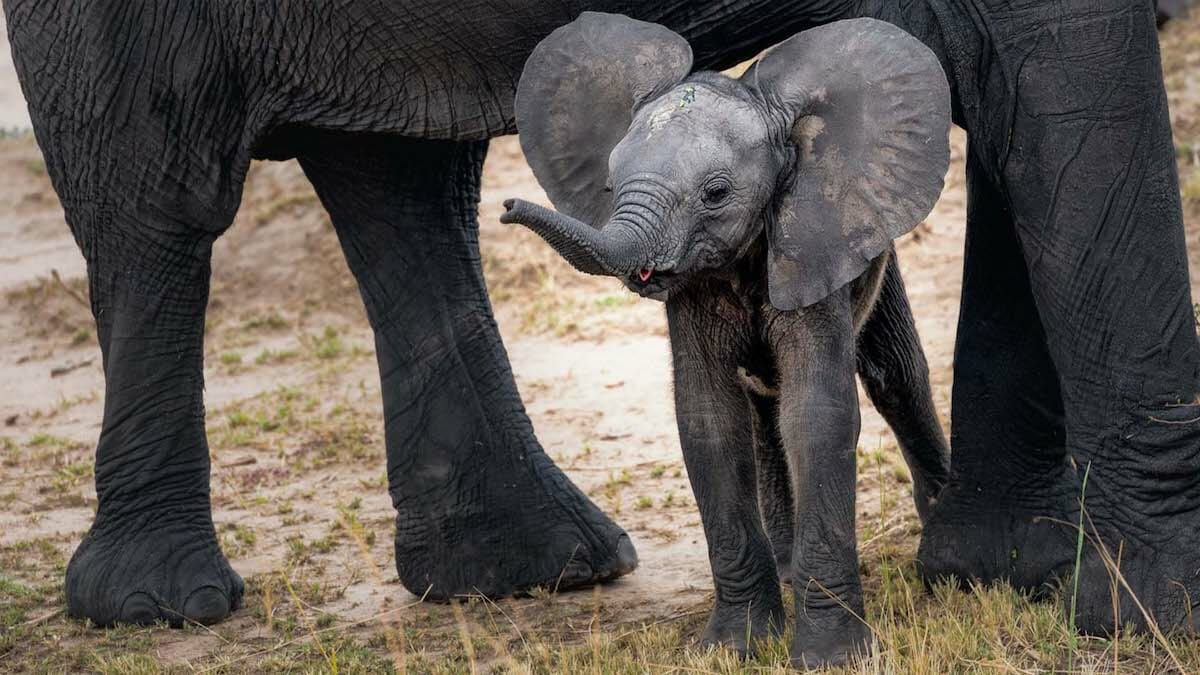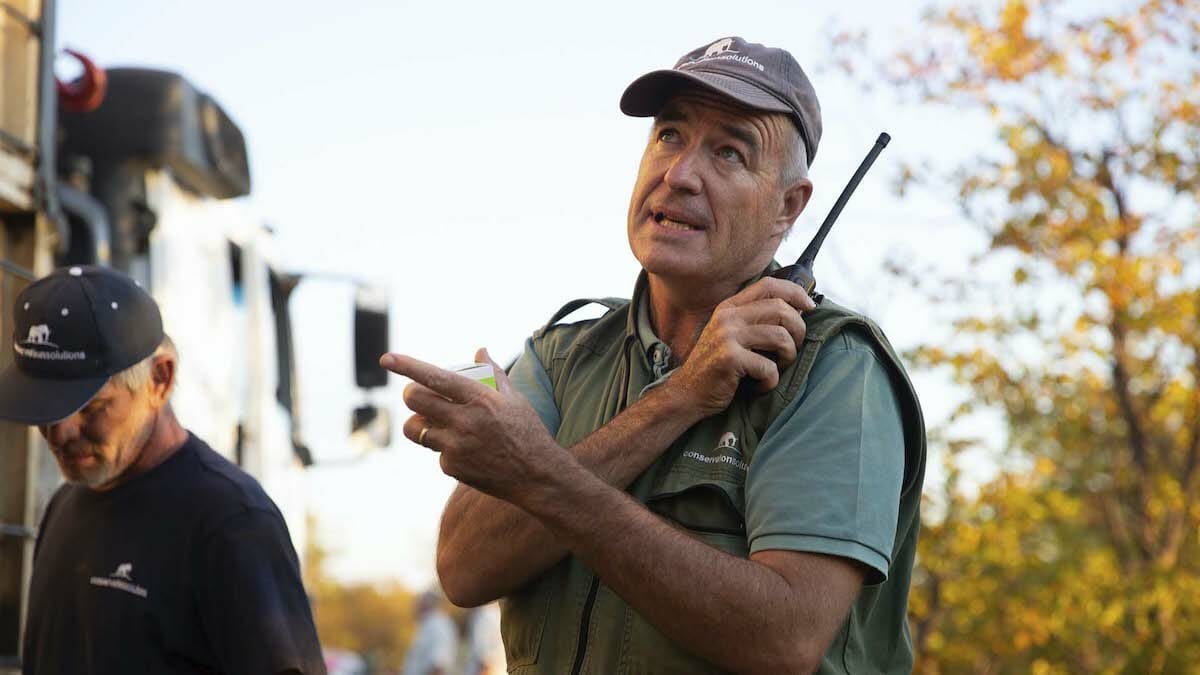
Responsibility / Biodiversity
By Grant Mobley. Updated August 15, 2025
Moving Giants: Securing a Future for Generations of the African Elephant
The birth of baby elephants in Zinave National Park is more than a joyful sight—it’s proof that a conservation vision of the African elephant has bloomed.
(Courtesy of De Beers)
Sometimes, it’s possible to have too much of a good thing. At De Beers Group’s Venetia Limpopo Nature Reserve (VLNR) in South Africa, a thriving ecosystem, fertile land, and a safe environment have allowed the African elephant population to grow beyond what the area can sustain. In contrast, other African regions have far fewer elephants than they should. Since 2018, the Moving Giants initiative—led by De Beers Group in partnership with Peace Parks Foundation—has worked to solve this imbalance, protecting the reserve while helping create the largest, healthiest African elephant population possible, and as a result, has created lasting, positive change for both people and the planet in two critical African landscapes.
Meet the Expert

- Grant Mobley is the Jewelry & Watch Editor of Only Natural Diamonds.
- He is a GIA Diamonds Graduate.
- He has over 17 years of jewelry industry experience, starting with growing up in his family’s retail jewelry stores.
The Difference Moving Giants Can Make

Between 2018 and 2019, more than 100 elephants traveled over 1,000 miles from VLNR to Zinave National Park in Mozambique, where the population had been devastated by the country’s 15-year civil war. The successful move remains the longest elephant translocation by road ever completed and has set new standards for safe, large-scale relocations across Africa.
Kester Vickery, co-founder of Conservation Solutions, lifelong elephant advocate, and expert in relocating large animals, has been a driving force behind the Moving Giants project. “Thanks to the ambitious Moving Giants initiative, we’ve proven that large groups of elephants can be moved safely over long distances,” Vickery says. “With this knowledge, we can now look to relocate elephants to areas once considered too far away.”
About These Miraculous Mammals: The African Elephant

Elephants are among the most fascinating and largest animals on our planet. In fact, they are the world’s largest land mammals, and their newborn calves are among the most advanced of any species. Weighing about 200 lbs (91 kg) at birth, they can stand three feet tall within minutes to reach their mother’s milk, while the females in the herd trumpet to announce news of their arrival.
Elephant mothers begin giving birth at around 15 years old and can have up to 12 calves during their 60- to 70-year lifespan. Their distinctive trunks contain roughly 150,000 muscle units, making them the most sensitive organ of any mammal. Elephants also communicate using seismic vibrations that travel through the ground and can be detected through their bones from miles away. Majestic and intelligent, elephants are more vital to the world’s ecosystems than many realize.
African Elephants as Climate Allies

African forest elephants are vital to carbon capture. As they forage, they thin out forests by removing smaller trees, allowing larger, carbon-storing trees to thrive. According to a 2020 International Monetary Fund report, restoring the species to historical population levels could capture carbon on a scale comparable to 250,000 trees.
Deforestation and poaching have reduced the population to about one-tenth of its former size. Scientists estimate that if restored to previous numbers, these elephants could contribute to carbon capture equivalent to 250,000 trees.
Why Do Elephants Need Our Protection?

The word “elephant” comes from the Greek elephas, meaning “ivory,” a nod to their tusks—which are actually teeth. But decades of poaching have driven a rapid evolutionary shift, and more baby elephants are now born without them. While tuskless elephants are more likely to survive the threat of hunters, this protection comes at a cost. Tusks are vital for stripping bark, digging for water, defending against predators, and moving heavy objects—making survival in the wild more challenging and altering the ecosystems they help shape.
With a $500,000 grant from the Anglo American Foundation, Moving Giants has supported community-led anti-poaching patrols, employing more than 80 rangers. Their vigilance, on foot, by boat, and by air, has kept African elephant and rhino poaching at zero since the program began.
In 2020, the park shared its first revenue with surrounding communities, investing 20% of earnings into projects like securing water supplies, advancing regenerative agriculture, and educating youth, ensuring local custodians directly benefit from the park’s continued protection.
Baby Elephants Signal a New Era
The birth of calves in Zinave for the first time in years was a turning point.
“It was incredibly exciting seeing the first elephant calves in Zinave for a long time”, said Trevor Landrey, operations manager for Peace Parks Foundation in Zinave. “It showed that the elephants were happy and healthy. They had clearly adopted Zinave as their new home, and it was satisfying to know they would be around in the park for our children and grandchildren to see.”
Vickery agreed: “It was proof to us that the translocation had been conducted successfully with minimal stress to the elephants themselves. It was safe to say that the elephants had settled into their new environment. They seemed relaxed in the park and were breeding well.”
For Erin Parham, head of biodiversity at De Beers, the calves were a highlight. “Not only was it nice to see photos of baby elephants, but it also demonstrated that the first translocations had been successful, that the elephants were settled and thriving in their new landscape, and that Moving Giants was helping to secure new life for generations to come.”
Since their arrival, the African elephant families have settled quickly, forming larger herds alongside others from different regions. Strong family bonds and healthy calves have driven a 6% natural increase in the population. As “ecosystem engineers,” they are regenerating Zinave’s forest habitat, creating conditions for rhino, zebra, giraffe, lion and leopard to flourish. Without their movement and grazing, the diversity needed to sustain this wildlife would not exist.
VLNR’s Continued Role in Aid of the African Elephant

The VLNR remains a secure and thriving refuge for elephants and other vulnerable species. Translocating 100 elephants to Zinave has significantly eased the pressure that the abundant elephant population was placing on the environment. Ongoing monitoring indicates that the ecosystem is replenishing, especially in its ancient riverine forests, where elephants feed on large fruiting trees and seek shade from the summer sun.
World Elephant Day
World Elephant Day, celebrated each August, is a moment to reflect on the responsibility to protect nature and plan future action. One way to mark the day: tune in to De Beers’ live nature reserve camera, offering a rare view of a waterhole visited by elephants and other protected wildlife.











